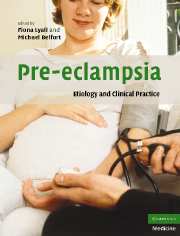Book contents
- Frontmatter
- Contents
- List of contributors
- Preface
- Part I Basic science
- 1 Trophoblast invasion in pre-eclampsia and other pregnancy disorders
- 2 Development of the utero-placental circulation: purported mechanisms for cytotrophoblast invasion in normal pregnancy and pre-eclampsia
- 3 In vitro models for studying pre-eclampsia
- 4 Endothelial factors
- 5 The renin–angiotensin system in pre-eclampsia
- 6 Immunological factors and placentation: implications for pre-eclampsia
- 7 Immunological factors and placentation: implications for pre-eclampsia
- 8 The role of oxidative stress in pre-eclampsia
- 9 Placental hypoxia, hyperoxia and ischemia–reperfusion injury in pre-eclampsia
- 10 Tenney–Parker changes and apoptotic versus necrotic shedding of trophoblast in normal pregnancy and pre-eclampsia
- 11 Dyslipidemia and pre-eclampsia
- 12 Pre-eclampsia a two-stage disorder: what is the linkage? Are there directed fetal/placental signals?
- 13 High altitude and pre-eclampsia
- 14 The use of mouse models to explore fetal–maternal interactions underlying pre-eclampsia
- 15 Prediction of pre-eclampsia
- 16 Long-term implications of pre-eclampsia for maternal health
- Part II Clinical Practice
- Subject index
- References
6 - Immunological factors and placentation: implications for pre-eclampsia
from Part I - Basic science
Published online by Cambridge University Press: 03 September 2009
- Frontmatter
- Contents
- List of contributors
- Preface
- Part I Basic science
- 1 Trophoblast invasion in pre-eclampsia and other pregnancy disorders
- 2 Development of the utero-placental circulation: purported mechanisms for cytotrophoblast invasion in normal pregnancy and pre-eclampsia
- 3 In vitro models for studying pre-eclampsia
- 4 Endothelial factors
- 5 The renin–angiotensin system in pre-eclampsia
- 6 Immunological factors and placentation: implications for pre-eclampsia
- 7 Immunological factors and placentation: implications for pre-eclampsia
- 8 The role of oxidative stress in pre-eclampsia
- 9 Placental hypoxia, hyperoxia and ischemia–reperfusion injury in pre-eclampsia
- 10 Tenney–Parker changes and apoptotic versus necrotic shedding of trophoblast in normal pregnancy and pre-eclampsia
- 11 Dyslipidemia and pre-eclampsia
- 12 Pre-eclampsia a two-stage disorder: what is the linkage? Are there directed fetal/placental signals?
- 13 High altitude and pre-eclampsia
- 14 The use of mouse models to explore fetal–maternal interactions underlying pre-eclampsia
- 15 Prediction of pre-eclampsia
- 16 Long-term implications of pre-eclampsia for maternal health
- Part II Clinical Practice
- Subject index
- References
Summary
Introduction
Pre-eclampsia only occurs during pregnancy, a physiological situation where allogeneic cells from two different individuals come into close contact. Furthermore, the development of the disease is dependent only on the presence of the placenta and not the fetus as the disease is frequently seen in complete hydatidiform mole where no fetus is present. Numerous epidemiological studies have given rise to the widely held view that immunological mechanisms probably contribute to the pathogenesis of this disease (and indeed other pregnancy disorders) (Dekker, 2002; Redman, 1991; Roberts and Lain, 2002; Walker, 2000). However, the molecular and biological mechanisms underlying this presumed maternal immune maladaptation remain unknown.
During pregnancy both the maternal and fetal immune systems would be expected to recognize the presence of each other's allogeneic cells. However, the acceptance of the fetal allograft by the mother is at variance with the rejection typically seen with organ grafts. If the transplant analogy is extended further it would be expected that the maternal immune reaction would exhibit both specificity and memory for particular paternal genes expressed by the placenta. In other words, is there a partner-specific effect which contributes to pregnancy success or failure? Therefore, in considering possible immunological factors in pre-eclampsia two broad questions arise: first, how does the maternal immune system normally allow a symbiotic relationship with the feto-placental unit and, second, can this symbiosis be altered in a partner-specific way in pre-eclampsia?
- Type
- Chapter
- Information
- Pre-eclampsiaEtiology and Clinical Practice, pp. 92 - 102Publisher: Cambridge University PressPrint publication year: 2007



